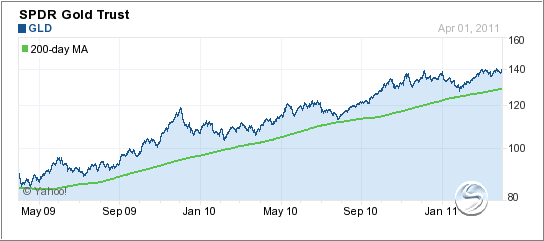That was the question which was recently discussed in an article titled ”For Gold Prices, Is the Bull Run Over?” Let’s look at some highlights:
After a decade-long bull run in the price of gold, the bears are beginning to come out of hibernation.
That may seem hard to believe after the recent run up in gold’s price. With conflict rising in Libya and the crisis still brewing in Japan, the price of gold rose to $1,428 an ounce, up an astonishing 28.8% in the last year. A decade ago, gold was selling for just $268.
“While we do expect inflation to remain a concern, investors who are focused on gold will likely start taking profits and move their money into riskier assets such as equities, which have performed really well in this market,” says Brian Bueno, an analyst at research firm IBISWorld, which has just published a report entitled, “Gold’s Long Bull Run Is Set to Turn Bear.”
Even some noted gold bulls are warning that prices have gone too high and that a major pullback may be in the offing. “Since early this year, I have become cautious about gold’s ability to push substantially higher over the near term and have expected instead to see a sharper decline,” wrote a commentator on Forbes.com. And investment adviser Mickey Fulp recently told Business Insider that gold is “overdue for a correction,” though he remains a long-term bull.
…
Bueno says the combination of Libya and Japan are driving investors into safe haven investments, like gold, temporarily, buts says these are short-term phenomena and that he is predicting the gold price to hover around $1,200 an ounce by year end, falling to $1,128 by 2013.
“We expect the price of gold to suffer major blows starting possibly this summer,” he says.
He bases his argument on the belief that investors will prefer riskier assets like stocks to gold because the global economy will be regaining strength in earnest by summer.
Bueno says another key sign of a downtrend is that the amount of new gold bought by exchange traded funds that invest in the precious metal fell by 2% in 2010 and that U.S. demand for gold coins and bars was down by 8%, both indicating a slackening of demand.
Dan Major, a metals analyst at the Royal Bank of Scotland in London, is not as pessimistic about the outlook as IBISWorld is, but he is predicting that the gold price will average $1,350 in 2011, and then drop to $1,300 in 2012, before rebounding to $1,375 the following year.
In his view, gold will become relatively unattractive as rising rates increase the so-called opportunity costs of owning assets such as gold, which don’t pay any interest. Opportunity cost is when a competing asset pays a better return, such as a short-term corporate bond or Treasury bill that pays its owner an interest rate.
“Gold and silver have become dependent on sustained inflows from investors, notably in the exchange traded funds,” says Major. But maintaining that flow will be difficult to achieve with interest rates headed upward, he adds.
There you have it; a view that is overall more bearish than bullish. While no one can be sure, the 2-chart of GLD above shows a perfect up trend that, from time to time, was interrupted by corrections of reasonable magnitude. However, the trend line was never violated to the downside.
A few days ago, gold made an all-time new high of $1,441, so if predictions of an average price for gold of 1,350 in 2011 hold true, that would merely represent a drop off the highs of some 6%. That is within the range the gold has been correcting/trading in.
While gold has always been pitched as a hedge against inflation; that sure did not work during the inflationary seventies. To my way of thinking, gold is a hedge against uncertainty as we have seen over the past few years.
With the world being full of hotspots, gold is likely to respond favorably in the face of any adversity or blow up. I always refer to these events as known and unknown uncertainties.
Currently, some of the known ones are property bubbles in China, Canada and Australia. Politically speaking, N. Africa and the Middle East are mired in unrest and protests some of which may end up in civil wars as we are seeing now in Libya. Then you have the European debt crisis with potential defaults by some of the current contenders on deck, like Greece, Ireland and Portugal.
Throw in an unknown uncertainty, like a major natural disaster as we’ve witnessed in Japan, and it becomes clear that smooth sailing the financial markets is questionable at best.
Yes, gold will continue to swing with varying degrees of magnitude depending on news events, but I would not count it out as an asset class that should have a presence in everyone’s portfolio.
Disclosure: Holdings in GLD
Chart courtesy of YahooFinance
Contact Ulli

Comments 1
And as we are learning from you: there is really no need to try and predict things like this. Just follow the trading rules. If you are in GLD or similar, hold until it hits your exit stop or until the trend reverses.